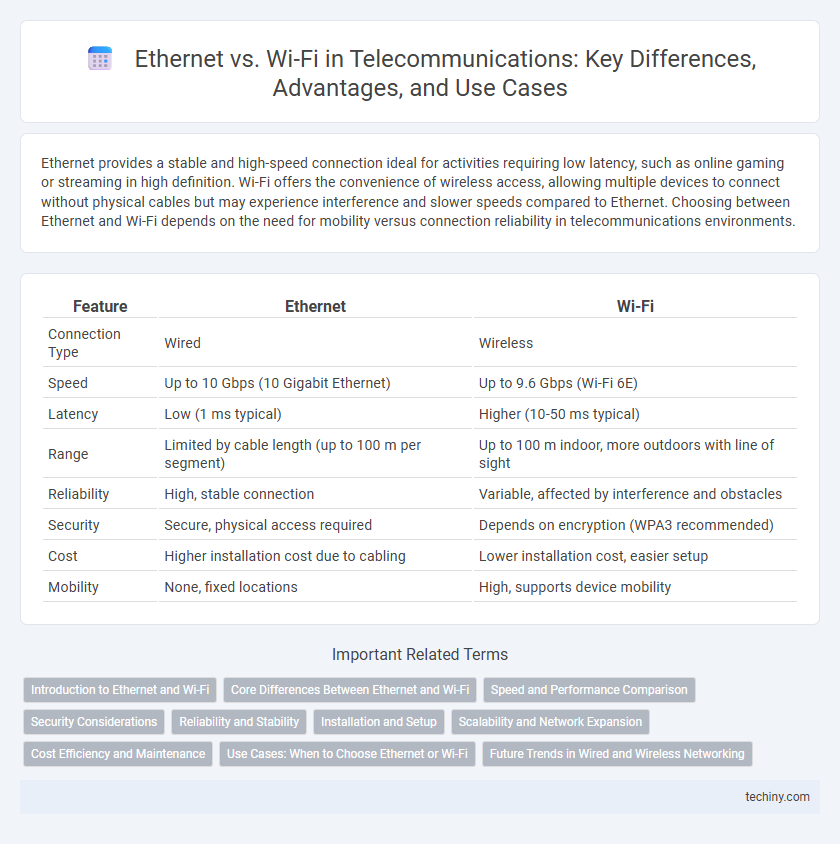Ethernet provides a stable and high-speed connection ideal for activities requiring low latency, such as online gaming or streaming in high definition. Wi-Fi offers the convenience of wireless access, allowing multiple devices to connect without physical cables but may experience interference and slower speeds compared to Ethernet. Choosing between Ethernet and Wi-Fi depends on the need for mobility versus connection reliability in telecommunications environments.
Table of Comparison
| Feature | Ethernet | Wi-Fi |
|---|---|---|
| Connection Type | Wired | Wireless |
| Speed | Up to 10 Gbps (10 Gigabit Ethernet) | Up to 9.6 Gbps (Wi-Fi 6E) |
| Latency | Low (1 ms typical) | Higher (10-50 ms typical) |
| Range | Limited by cable length (up to 100 m per segment) | Up to 100 m indoor, more outdoors with line of sight |
| Reliability | High, stable connection | Variable, affected by interference and obstacles |
| Security | Secure, physical access required | Depends on encryption (WPA3 recommended) |
| Cost | Higher installation cost due to cabling | Lower installation cost, easier setup |
| Mobility | None, fixed locations | High, supports device mobility |
Introduction to Ethernet and Wi-Fi
Ethernet provides a wired connection using twisted-pair or fiber-optic cables, delivering consistent high-speed data transfer and lower latency for network communications. Wi-Fi operates through wireless radio waves, offering mobility and convenience with varying speeds depending on standards such as IEEE 802.11ac or 802.11ax. Each technology serves distinct networking needs, with Ethernet preferred for reliability and Wi-Fi chosen for flexibility and ease of access.
Core Differences Between Ethernet and Wi-Fi
Ethernet provides a wired connection that ensures higher stability, lower latency, and faster data transfer speeds compared to Wi-Fi, which relies on wireless signals subject to interference and signal degradation. Wi-Fi offers greater mobility and convenience by allowing multiple devices to connect without physical cables, but it typically experiences variability in speed and potential security vulnerabilities. Key technical distinctions include Ethernet's use of physical cabling like Cat5e or Cat6, supporting gigabit speeds and more consistent bandwidth, whereas Wi-Fi operates on radio frequencies such as 2.4 GHz and 5 GHz bands with speeds influenced by distance, obstacles, and network congestion.
Speed and Performance Comparison
Ethernet offers consistently higher speeds, often reaching up to 10 Gbps with lower latency and minimal interference, making it ideal for bandwidth-intensive tasks and stable connections. Wi-Fi speeds vary significantly depending on standards like Wi-Fi 6, which can achieve up to 9.6 Gbps in optimal conditions, but are generally susceptible to signal degradation and interference from other devices. For performance-critical applications such as online gaming or large data transfers, Ethernet delivers superior reliability and speed compared to wireless networks.
Security Considerations
Ethernet connections provide enhanced security through physical cabling, reducing vulnerability to wireless interception and unauthorized access. Wi-Fi networks rely heavily on robust encryption protocols such as WPA3 to mitigate risks like eavesdropping and man-in-the-middle attacks. Implementing strong authentication methods and regularly updating firmware are critical for maintaining secure wireless communication.
Reliability and Stability
Ethernet provides superior reliability and stability due to its physical wired connection, minimizing interference and signal loss common in wireless networks. Wi-Fi, while offering flexibility and mobility, is prone to fluctuations from environmental factors such as distance, obstacles, and electromagnetic interference. For critical applications requiring consistent bandwidth and low latency, Ethernet remains the preferred choice in telecommunications infrastructure.
Installation and Setup
Ethernet installation requires running physical cables such as Cat5e or Cat6, ensuring stable and high-speed connections with minimal interference, ideal for permanent setups. Wi-Fi setup involves configuring wireless routers or access points, offering flexibility and ease of deployment without the need for extensive wiring, suitable for mobile and dynamic environments. Ethernet setup demands more time and labor upfront but provides consistent bandwidth, whereas Wi-Fi prioritizes convenience and scalability during installation.
Scalability and Network Expansion
Ethernet offers superior scalability through its structured cabling systems and high bandwidth capacity, making it ideal for large-scale network expansions in telecommunications infrastructure. Wi-Fi provides flexible network expansion with minimal physical constraints, enabling rapid deployment across diverse environments but may face challenges in maintaining consistent performance as user density increases. Integrating Ethernet backbones with Wi-Fi access points optimizes scalability, combining robust wired connections with adaptable wireless coverage for comprehensive network growth.
Cost Efficiency and Maintenance
Ethernet offers greater cost efficiency through lower initial infrastructure expenses and minimal ongoing maintenance compared to Wi-Fi, which requires continuous updates and security measures. The wired connection reduces troubleshooting frequency and downtime, significantly lowering maintenance costs over time. Wi-Fi networks often incur higher expenses due to signal interference, hardware upgrades, and complex support requirements.
Use Cases: When to Choose Ethernet or Wi-Fi
Ethernet is ideal for high-speed, low-latency applications like online gaming, video conferencing, and large file transfers where reliability and consistent performance are critical. Wi-Fi offers greater mobility and convenience for everyday tasks such as web browsing, streaming, and connecting multiple devices without physical cables. In environments with dense device usage or where physical wiring is impractical, Wi-Fi provides flexible connectivity, while Ethernet remains the preferred choice for fixed workstations and infrastructure requiring stable connections.
Future Trends in Wired and Wireless Networking
Future trends in wired and wireless networking highlight the growing integration of Ethernet and Wi-Fi technologies to meet increasing data demands and low-latency requirements. Ethernet advancements focus on higher speeds with 400 Gbps and beyond, leveraging fiber optics and Power over Ethernet (PoE) for enhanced stability and power efficiency in enterprise networks. Wireless innovations emphasize Wi-Fi 7 and 6E adoption, delivering multi-gigabit speeds, reduced interference in the 6 GHz band, and seamless connectivity for IoT and smart city deployments.
Ethernet vs Wi-Fi Infographic

 techiny.com
techiny.com